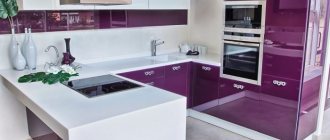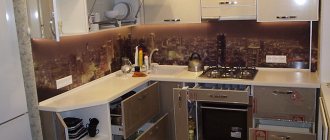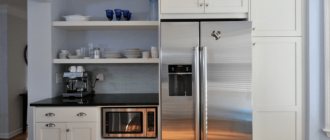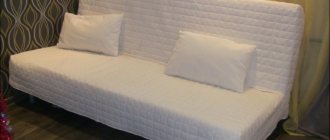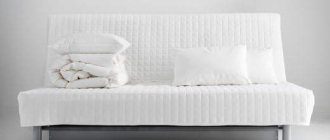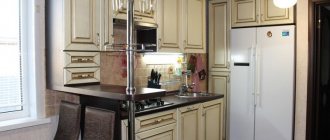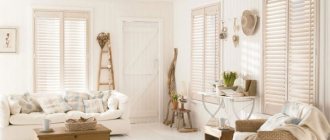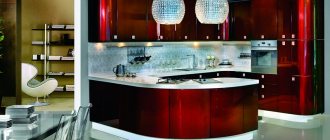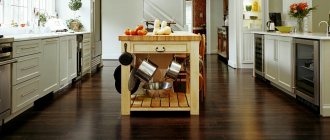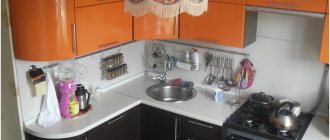Beautiful and elegant wooden kitchens are suitable for various types of interiors and look very expensive. But they cost accordingly. A modern alternative to solid wood is the use of veneer.
At first glance, veneered kitchens cannot be distinguished from sets made of natural wood.
In this article, we suggest looking at a selection of photos of various kitchens using veneer and understanding the features of this material.
Veneer can be very diverse.
What is veneer?
Veneer, or veneered MDF, is finely divided boards covered with a thin layer of natural wood up to one millimeter thick. Due to the fact that MDF shavings are impregnated with paraffin or linguine and then pressed under the influence of temperature, the panels are durable and can withstand harsh operating conditions in the kitchen.
A thin cut of natural wood provides a beautiful appearance and is similar in appearance to natural wood. It is glued onto MDF and then coated with varnish or a special paint coating.
Thanks to the protective layer, this headset is very durable
At the same time, veneer can be very diverse: different shades and patterns of wood decorate both traditional and modern kitchens.
Where is it used?
Wood veneer is used for decorative purposes in the furniture and woodworking industries. It is used to finish surfaces made of cheap materials. Veneer coating creates the effect of natural wood at a low cost of the finished product. Thin veneer is used in the manufacture of door panels, as well as finishing wall panels. This material is used to make matchboxes, produce fruit boxes, and is also used in the technology of producing multilayer plywood sheets.
The base for veneering can be a sheet of chipboard, MDF, or plasterboard. Wood cut sheets are suitable for restoration work when repairing used furniture. Sliced veneer is used in the manufacture of sports equipment, designer souvenirs, household items and much more. Sawn veneer is used in the creation of musical instrument cases, doorways and arched structures, exclusive furniture models, boxes, panels, and gift products. The colored veneer of noble wood species is a subject for creativity.
Preparation method
It is important to understand that veneer facades are also different. A lot depends on the manufacturing method. In total, there are three methods for producing veneer panels.
Depending on the manufacturing method, different types of veneered kitchens are obtained
The most common method is peeled veneer. For it, a special peeling machine is used, which cuts the logs using a special technique, in a spiral. At the same time, manufacturers strive to select the most beautiful wood with unusual patterns.
The thickness of the veneer sheet is regulated directly by the master and it can range from 0.3 to one and a half millimeters. Mass production made such veneer affordable. The unusual appearance also adds to the attractiveness - the machine allows you to preserve the structure of the wood and its characteristic stains.
This method allows you to preserve the texture of wood even on the thinnest layer of veneer
For sliced veneer, special types of saws and wood are used. It is noteworthy that this particular technique makes it possible to process the most valuable types of wood - mahogany, alder, oak. Different directions of the cutting edge allow you to emphasize the beauty of the pattern and give it texture. This way, graceful and elegant veneered facades are obtained, however, they are quite expensive.
Dark oak veneer panels are made in this way
The sawn method of making veneer is considered one of the most inconvenient. Wood boards are processed with a special plywood saw. However, with this method, a lot of wood is used for sawdust, so the cost of manufacturing it is much higher than in the two previous cases. The method is used because it helps preserve the beauty and characteristic pattern of coniferous wood.
Light pine wood is best treated this way.
What types of wood veneer are there?
Sliced veneer
As for this product group, it has the following differences:
- sheets are produced on special veneer cutting equipment, characterized by high precision and cleanliness of processing;
- product thickness can vary from 0.2 to 5 millimeters, which is sufficient for most uses;
- This production method is used when working with valuable wood species, as it allows their structure to be presented in the most favorable light. The most commonly used wood for work is oak, walnut, beech, Karelian birch, acacia, ash, yew and much more.
You should remember one simple rule: the thicker the veneer, the more reliable it is, so you shouldn’t save money and buy the thinnest options
Peeled veneer
The production of wood veneer using this technology has the following features:
- The production process is very simple: logs are cut into pieces of small width, after which they are cut into sheets of small thickness using a special knife. The quality of this option is noticeably lower than the first, but the cost is lower, so it is the most popular;
- The following types of wood are most often used for work: pine, birch, alder and oak;
- The thickness of the finished elements can be from 0.1 to 10 millimeters, which allows you to choose the optimal solution for any type of work.
Sawn veneer
As for this type of product, the following can be noted about it:
- products are produced on special machines that cut the block layer by layer, due to the large amount of chips that are formed during work, the cost of the material is high;
- the thickness of the lamellas, which is what the finished elements are called, can range from 1 to 10 mm;
- Products of this type are of particularly high quality, so they are very often used in the production of musical instruments; they can also be used in the interior and in the manufacture of furniture; such surfaces practically do not require additional processing.
It is important to choose the option that is best suited in a given situation, and if the manufacturer has recommendations for use or special instructions for carrying out work, then all requirements must be followed in order to obtain a guaranteed high result. One simple rule should be remembered: the thicker the veneer, the more reliable it is, so you should not save money and purchase the thinnest options
Veneer is one of the materials whose popularity never decreases; moreover, with rising wood prices, the demand for this option will be even greater
One simple rule should be remembered: the thicker the veneer, the more reliable it is, so you should not save money and purchase the thinnest options. Veneer is one of the materials whose popularity never decreases; moreover, with rising wood prices, the demand for this option will be even greater.
Facade type
Like most non-monolithic kitchens, veneer fronts come in different shapes. A solid facade will be cheaper - in fact, it is a simple panel covered with veneer on all sides. It looks beautiful and externally such surfaces resemble solid wood.
However, you should use them carefully in the kitchen: veneer may be thin, but it is still wood. This means that it has all the disadvantages and can be blown away and deformed from contact with water and constant temperature changes. If the facade is covered with veneer carelessly, it is unlikely to serve you for more than a couple of years.
The solid veneer facade looks beautiful, but it is not particularly durable
A framed or paneled veneer façade will cost you a little more. In this case, the panel is covered with veneer, and the edges are trimmed with metal, plastic or treated wood. Of course, they are not too cheap. However, such a frame reliably protects the surface from drops of water and grease getting under the veneer, which means the set will last you much longer.
A set with a frame will cost more, but will also last longer.
Types of doors
The essence of creating veneered doors comes down to gluing the veneer onto the frame. At the same time, both the frames and the methods of attaching the veneer covering to them can be different.
Veneer interior door with glass inserts
Veneered doors and eco-style
Advantages and disadvantages
Like any other facades, veneered ones have both advantages and disadvantages. We suggest you study this aspect in detail so that you know what problems you are likely to encounter.
Veneered kitchens look stylish and have a lot of advantages
- No matter how high-quality plastic or PVC film is, they can only imitate wood . This means that upon closer inspection the fake will be noticeable. Veneer is completely natural wood, albeit very thin. Even with meticulous study, high-quality veneer facades are indistinguishable from kitchens made of solid wood.
- If the veneer is treated with varnish or a special paint coating, it will be resistant to any of the most unpleasant influences that occur in the kitchen - high temperatures, mechanical damage, moisture and steam, drops of fat and various acids.
- Like any wood, veneer can be restored. Of course, we are not talking about serious damage - in this case you will need to install a patch. However, small scratches and abrasions can be easily hidden and the kitchen restored to its original appearance.
- It cannot be denied that veneer facades look truly luxurious. A set made of solid wood looks exactly the same, but costs several times more.
- The material is environmentally friendly, does not contain harmful impurities and is non-toxic to humans even when heated. This means that veneered facades can be installed even in close proximity to the stove - there will be no toxic fumes that often occur with plastic or PVC film.
- Caring for veneer kitchens is very simple : just wipe them regularly with a damp sponge and then wipe dry. Some people use special polishes that add shine to surfaces. However, in the kitchen we recommend avoiding such products: they attract dust and other debris, which means maintenance becomes more difficult.
However, if you thought that a veneered kitchen was the ideal solution, we will disappoint you.
- It is almost impossible to visually determine the quality of veneered furniture . This means that if you were sold a not very high-quality headset, you will most likely find out about it already in the process of using it. You can avoid the problem if you contact only trusted furniture stores and craftsmen who value their reputation.
- The problem stemming from the previous drawback is the low quality of some veneered kitchens. Veneer can become deformed, peel off... This happens due to the influence of moisture, fat, steam and constant temperature changes. Therefore, we emphasize once again that you should not save on buying a kitchen set.
- In any case, its cost will be higher than that of film or plastic facades. However, you pay for a spectacular appearance, quality and environmental friendliness.
- Like any wood, veneer does not tolerate direct sunlight very well. Under their influence, wood can darken and change shade. This can be avoided by varnishing the veneer. We strongly do not recommend leaving it without a protective coating.
As you can see, most of the disadvantages of veneered kitchens can be avoided if you purchase high-quality sets from trusted places. As for expenses, if you have a good kitchen, they will pay off very quickly.
In general, we strongly recommend veneered kitchens: they are worth it!
Tips for selection and care
When choosing veneered furniture, the following main criteria are important:
- price;
- environmental friendliness;
- durability and wear resistance;
- aesthetic qualities;
- maintainability.
An important point is the design of the room. Modern artificial materials are excellent for implementing bold design projects, providing an unlimited range of shades, textures, and patterns. Natural material is perfect for classic room designs, combining the beauty of natural wood and the environmental friendliness of natural materials.
Natural materials require careful care without the use of aggressive chemicals.
It is enough to wipe such surfaces with a cotton rag using a soap solution. Artificial analogues are not so capricious to care for. But it is necessary to use cleaning products without abrasives, alkalis, or solvents.
Veneer color palette
If you think wood is a boring and monotonous material, then you are absolutely wrong. A wide variety of types of wood are used for veneer, which allows us to provide customers with a wide range of coatings of the most unusual appearance.
Veneer kitchens can be very diverse
Luxurious oak facades will suit both classic and modern interiors. Oak wood can have different shades, but its characteristic feature is its unusual rounded patterns that add gloss and nobility to even the simplest furniture.
Black oak veneer kitchen - for lovers of expensive elegance
Alder veneer is distinguished by its delicate, light color and velvety-looking texture. It is perfect for kitchens in country style, Provence. Another advantage of alder is its high resistance to mechanical stress. Very often, such a coating is not even varnished, since it already tolerates moisture and temperature changes very well.
Alder is ideal for most interiors.
A set with a rosewood facade will cost you quite a lot. However, unusual patterns and textures of wood are definitely worth the expense - the kitchen will look truly luxurious and elegant.
The peculiarity of cherry veneer is its reddish tint. It is perfect for a Baroque style kitchen. Moreover, cherry panels do not fade over time, but, on the contrary, the shade becomes much deeper and more noble.
The peculiarity of a cherry kitchen is its deep color
The cool, light shade of ash is ideal for small kitchens or south-facing spaces. Ash must be treated with varnish or a special protective coating, otherwise the color very quickly becomes dull, losing its charm.
Walnut veneer has a rich structure. Depending on the type and age of the tree, the shade may vary, but always remains consistently warm. Such facades will decorate kitchens facing north and will slightly dilute the lack of light.
Walnut kitchens are always distinguished by warm tones
A fashionable way to process veneer is zebrawood. The unusual striped color looks very expensive and unusual, and therefore will suit both classic and modern interiors.
Zebrawood is a modern and very fashionable type of veneer
As you can see, choosing the right option for a veneered kitchen is not difficult - the main thing is to find the type that you like.
Veneered kitchens are easy to find to suit every taste
In addition, you can radically change even the appearance of the familiar alder by applying a special varnish or protective coating to the facade. Depending on your choice, veneer can acquire a matte or glossy texture. The first option is ideal for classic kitchens - it looks elegant, restrained and rich. Shiny glossy options will fit well into modern interiors and visually enlarge a small kitchen.
The glossy structure is suitable for modern interiors.
Matte veneer looks very noble
Types of veneer in the interior
A home is not just a place to live and relax, but also a means of self-expression for the owner. There is a certain fashion for interiors. Among the variety of styles it is easy to find your own option. Furniture is an important component of any project. She brings the designer's fantasies to life. Veneered furnishings will decorate any space.
- To create an original interior in a rustic and rustic style, facades lined with wood cuts are used. Sliced oak veneer in a kitchen set looks decent, is not afraid of moisture and frequent use.
- Classic style assumes discreet luxury, natural colors, and strict lines. The living room or library will be decorated with cabinets inlaid with precious wood.
- Minimalism also readily uses furniture cladding in the interior. It is not necessary to select expensive varieties. Luxury is alien to this style.
- Provence lovers choose veneer with an aged effect, bleached oak. Such shades refresh and visually expand the space.
- Fine-line material is suitable for a high-tech interior. After all, with its help you can create the effect of a stone. Strict geometry and cabinet furniture are characteristic of this style.
- Loft is functionality, laconicism, a combination of steel and wood. The veneer will serve as decoration and create accents.
- Ecostyle is a desire for nature, naturalness in everything. Design connoisseurs choose natural materials. Sawn veneer is suitable for cladding unusual furniture with rounded shapes.
- For the oriental interior, exotic, valuable, expensive tree species are chosen. Inlaid designer furniture is the highlight of the style.
- The Scandinavian interior is characterized by simplicity, a minimum of things, and a lot of air. Pine and other softwood veneers are ideal for beds and wardrobes.
The material solves any problems facing the designer during the implementation of the project.
Decor
Despite the fact that veneer itself is a material with a smooth structure, very often veneered kitchens are decorated with various decorative elements. For example, carved elements made of natural wood. They significantly increase the cost of your kitchen, but the appearance only benefits from it.
Curly veneer facades are expensive, but the appearance is stunning
Often, various ornaments are used as decoration for veneered kitchens: ethnic, floral, geometric motifs. We recommend choosing depending on the design style of your kitchen.
And sometimes the texture of the wood itself becomes a decoration
If you have a small kitchen, voluminous decorative elements may not be very appropriate: they will visually make the room even smaller. However, in this case, you can experiment with different textures. For example, a special primer helps to visually age the set - an excellent solution for classic kitchens or baroque-style rooms.
Aged veneer - another fashionable technique
As an option, try choosing a suitable shade and applying a patina. It makes even the simplest set look elegant and expensive.
With patina, veneer looks more noble
Care
In order for veneered items to serve for a long time and be pleasing to the eye, they must be maintained in proper condition. To do this, take into account the characteristics of the wood plates with which the surfaces are covered.
- Stains appear not only from spilled liquids, but also from contact with hot or cold objects. This is especially true for kitchen tables. Place the kettle or pots only on special stands.
- The moisture resistance of veneer is not unlimited. Prolonged contact with large amounts of liquid damages it. The material may peel off.
- Abrasive substances and hard brushes leave scratches. All types of cleaning are carried out only with soft napkins, without aggressive chemicals.
- Antistatic agents will allow you to wipe dust from surfaces less often.
- Impacts and mechanical impacts cause chips and cracks.
- Veneer changes color from prolonged exposure to ultraviolet radiation. If possible, furniture with cladding is placed away from windows.
To disguise small scratches, special pencils and waxes are used. The coating is sanded very carefully, because the thickness of the veneer is only a few millimeters. In this it loses to solid wood furniture, which can be reconstructed even in case of severe damage. But in general, objects made from veneered MDF are more stable and resistant to environmental influences. The surfaces are periodically polished to recreate the original appearance. Following these simple rules will extend the life of veneered furniture.
PARRA offers spectacular veneer furniture at an attractive price. Here you will find many furnishing options in different colors and designs. Visit our online catalog and choose stylish furniture to decorate your home!
How to care
When it comes to maintenance, veneer is not too demanding, but it has its own characteristics. It is necessary to take into account that this is, first of all, natural wood, so an appropriate approach is needed.
To prevent the kitchen from losing its appearance, you need to take care of it
For daily care, a soft sponge or lint-free cloth will be enough. Wet them in water and then wipe the surface. After this, wipe dry with a soft towel. If there are stains or stains in the kitchen, you can use a soap solution or a special wood cleaner.
It’s not difficult to clean veneer if you don’t start cleaning
If you decide to use polish, you will need to degrease the surface first. To do this, you can use a weak solution of alcohol or, if desired, a regular window cleaner. Gently wipe the set, wipe it dry, and then apply polish and let it dry.
Important! Never use abrasive detergents or hard sponges. They will scratch the surface and you will need to spend effort and money on restoring the headset.
Reviews about veneered kitchen
Especially for you, we have collected several reviews from users of veneer sets. We are sure that after reading them, you will easily make a decision and understand whether you want to purchase such a kitchen.
The advantage of veneer is that abrasions do not spoil it, but, on the contrary, add charm.
Veneer is a simple and easy-to-maintain material that does not require special care.
The main thing is to at least occasionally wipe the veneer from dust and dirt.
Choose a high-quality kitchen and there will be no problems.
Peeling varnish is easy to renew, but durability is a definite plus.
